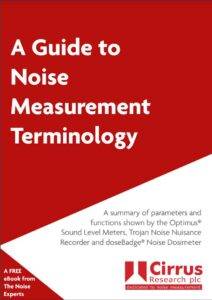What is Type or Pattern Approval?
Type Approval, or Pattern Approval, is a method where a recognised test laboratory, such as the PTB in Germany or LNE in France in the case of sound level meters, tests an instrument against a set of recognised and published standards to ensure that it meets the performance claims of the manufacturer.
The laboratory will test a number of samples of the product to check that they all meet the required standard. Once this has been completed and all of the samples have passed the tests, that particular model, or type, is approved and certified as meeting the claimed standards.
To learn more about the difference between pattern and type approval, and other acoustic terms that will help you to use and understand your noise measuring equipment better, check out our FREE guide to noise terminology.
This is the same process that is applied to, for example, cars. When a car manufacturer wants to sell a new model in the European Union, it must undergo tests to ensure that it conforms to the required standards. It’s not possible to crash test every vehicle so a number of sample vehicles are tested and when they have all passed, the vehicle type is approved.
Sound level meters from reputable manufacturers will be designed to meet certain International standards. These standards lay down the performance criteria for the instrument and how it should perform under specified conditions, and they are usually published as an International standard, followed by a regional or national version. This is the reason why there are often slight differences in the dates of published standards.
There are quite a few different standards that a sound level meter may be designed to meet. Below is the list of standards that the optimus sound level meters have been designed to meet:
- IEC 61672-1:2013 Class 1 (Class 1 instruments in the Optimus Red & Optimus Green family)
- IEC 61672-1:2002 Class 1 or Class 2 Group X
- IEC 60651:2001 Type 1 I or Type 2 I
- IEC 60804:2000 Type 1 or Type 2
- IEC 61252:1993 Personal Sound Exposure Meters
- ANSI S1.4 -1983 (R2006)
- ANSI S1.43 – 1997 (R2007)
- ANSI S1.25:1991
- 1:1 & 1:3 Octave Band Filters to IEC 61260 & ANSI S1.11-2004
The primary standard that the optimus sound level meters are designed to meet is the IEC 61672 standard. This has superseded and replaced the older IEC 60651 and IEC 60804 standards but these are still quoted as they are still referred in measurement standards that are yet to be updated.
In many countries, there is a requirement to have measurement instruments independently tested to ensure that they do indeed meet the claims of the manufacturer. This requirement is often specified in measurement standards, guidelines and regulations.
Cirrus has submitted the Class 1 optimus sound level meters to a number of different National test laboratories and testing organisations including the PTB in Germany and LNE in France and these laboratories carry out a set of tests to verify the performance of the instrument.
Once these tests have been completed and the instrument has been verified as meeting the claimed standards, a certificate is issued and the information about the approval is published by the test laboratory.
The tests that are carried out by these laboratories are specified in Part 2 of the IEC 61672 standard. The IEC 61672 standard is in three parts.
The first of these is known as Electroacoustics â- Sound level meters - Part 1: Specifications and this defines the performance specifications for the instruments. This is the document that sound level meter manufacturers use to design their instruments against.
Part 2 is known as Electroacoustics – Sound level meters - Part 2: Pattern evaluation tests and this defines the tests and checks that a laboratory must carry out when they are testing an instrument for Type or Pattern approval. These are the tests that have been carried out on the optimus sound level meters by the test laboratories such as the PTB and LNE.
Part 3 is known as Electroacoustics - Sound level meters - Part 3: Periodic tests and this defines the tests that should be carried out during a Periodic or routine verification.
Related posts
IEC 61672 – A standard for sound level meters in three parts
LNE Type Approval for the CR:515 Acoustic Calibrator
PTB Type Approval for the Optimus Sound Level Meters
Jaymee-lee Tolliday
Latest posts by Jaymee-lee Tolliday (see all)
- Turning Down the Volume: How the Trojan Noise Nuisance Recorder can help create a quieter world - 13th February 2024
- Festive Opening Hours 2023 - 6th December 2023
- Award of Excellence for Cloud-Based Monitoring Solutions 2023! - 20th November 2023

